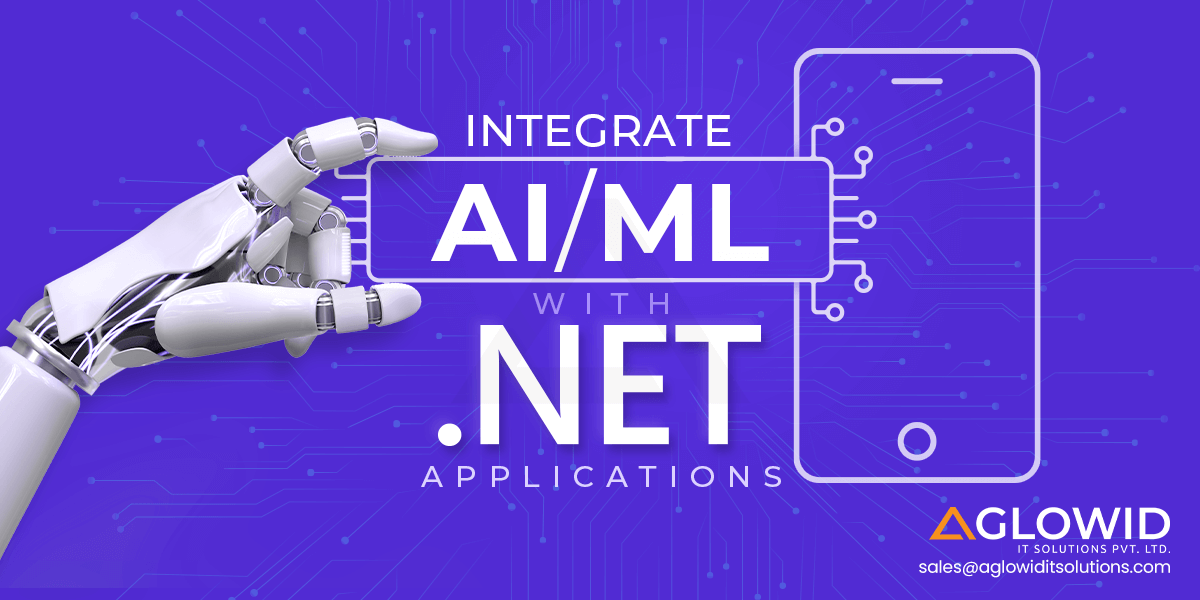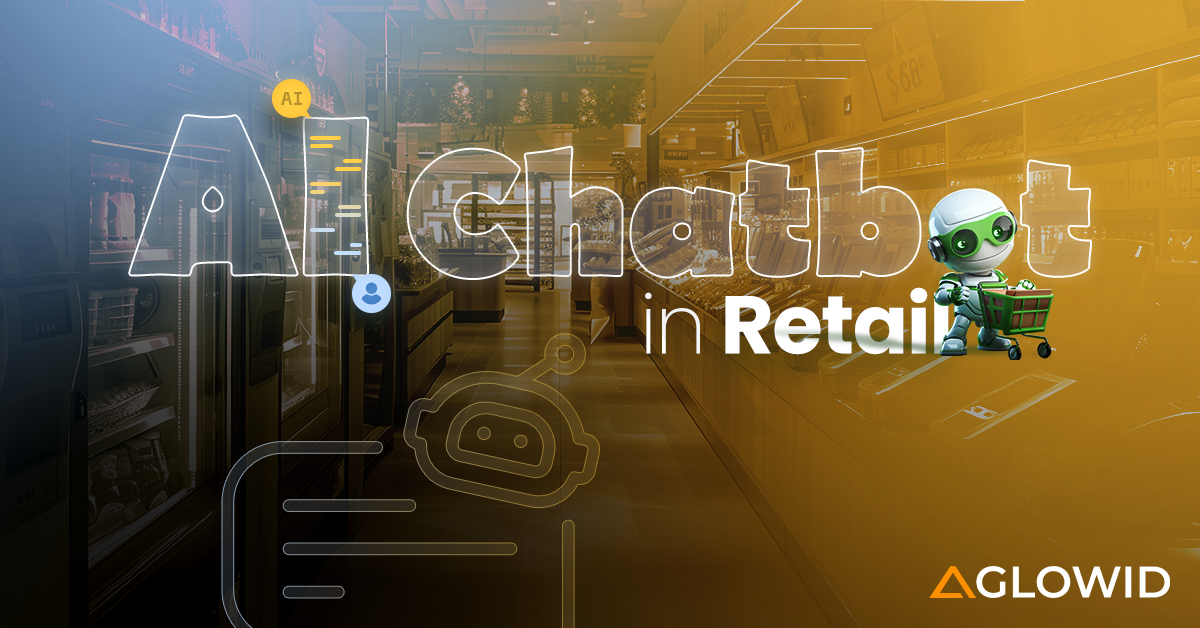Quick Summary:
Projects like Power BI and Bing Search Engine are integrating ML.NET in their applications to deliver top-notch AI-driven services to their users. What if we told you could do the same? With the advent of effective AI and ML frameworks and libraries, you can integrate AI/ML with .NET applications effectively. Intriguing right? Today, we will cover the why and how of .NET machine learning capabilities so you can make your next strategic choice.
At the dawn of the technological revolution, all we needed was scalable solutions that could handle the increasing complexity of our growing business. However, now at the cornerstone of the new AI-driven technological era, we also need intelligent systems that can adapt to our changing requirements as and when needed. .NET is at the forefront of this innovation-driven era.
As businesses increasingly focus on creating interactive and rich user experiences with next-generation features like recommendation systems, sentimental analysis, and more, integrating AI and AML in .NET applications is becoming strategically imperative.
Today, we are going to discuss the integration of AI and ML in .NET projects – How, Why, and Top .NET AI/ML frameworks to help you make the AI-driven change to your traditional .NET project.
📝 In this blog, we’re going to discuss…
How to Integrate AI/ML to .NET Applications?
Integrating AI/ML to a .NET application requires following a couple of steps, from defining the use cases to monitoring and updating deployment models. A proper step-by-step process for integrating AI/ML into your .NET app can help as a guide and reference point to ensure you take the most optimal route to creating a perfect .NET AI project. Let’s break it down –
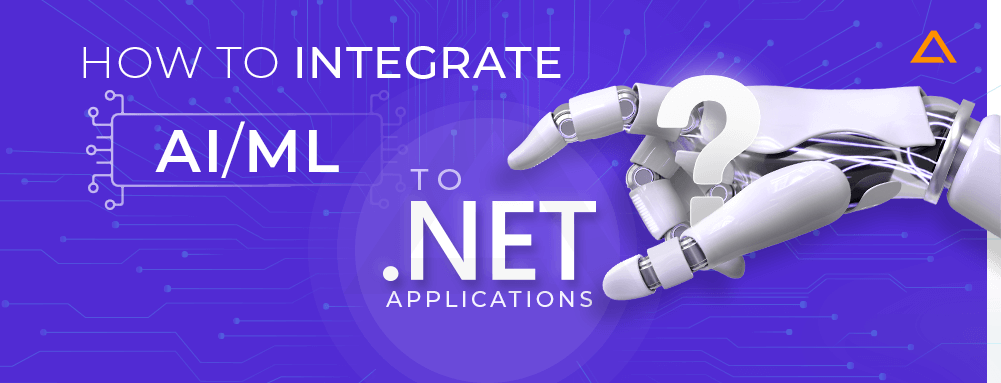
Start by defining use cases
Technology integration should always be catered towards a purpose. Answering what you want to achieve with AI/ML will help you find the right AI/ML solution for your project. Your project can easily have more than one type of AI/ML implementation in your app.
A few of the leading and popular AI/ML use cases include –
- Predictive Analysis: Prediction of future trends or outcomes based on historical data.
- Image Recognition: Identifying and classifying different objects in images.
- NLP (Natural Language Processing): Ability to understand and process human language.
- Recommender System: Personalized recommendations to users.
- Anomaly Detection: Detecting unusual patterns in data.
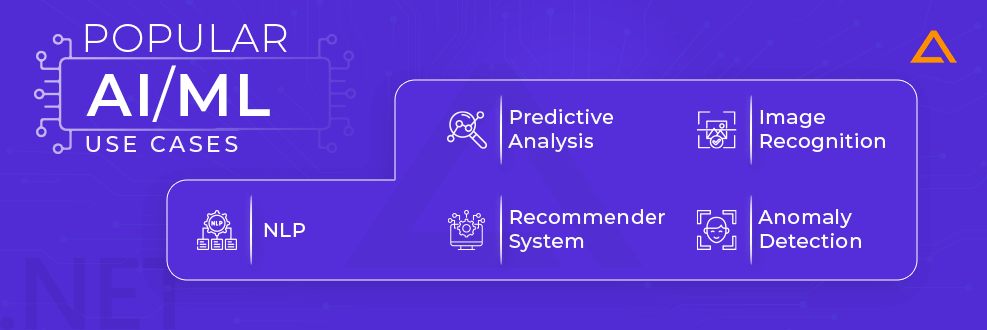
Gather Relevant Data from Credible Sources
Next, one of the most important steps of the process is to find, gather, and prepare the data needed to train and evaluate your machine-learning model. You must ensure that the data represents the problem you are trying to solve. You can find data banks in databases via APIs or external datasets.
Select the Ideal Tool from the List of .NET AI Frameworks
NET offers numerous AI/ML platforms that are compatible and can be utilized to integrate machine learning capabilities into your .NET application, taking into account the associated costs to build a .Net App. By matching the use case to the tool’s unique features and considering other important considerations, you can pick the right .NET ML framework for your project.
Here is a Basic Selection Guide for .NET AI Frameworks:
- Compatibility: First things first, you need to check if the clothes fit! In this case, you should conduct a proper inspection to determine if the .NET machine library you plan to use is compatible with your app’s .NET version and platform.
- Ease of Use: If you hire .NET developers or take the project independently, you should gauge the developers’ skills and scan for .NET AI/ML frameworks that are relatively easier to use or come with proper documentation and active community support.
- Flexibility and Scope: If you have a specific one-time AI/ML requirement, you can go for any tool that offers proper support. However, AI tools are multi-purpose most of the time. Hence, you should find a .NET AI framework that gives you more options for addressing diverse use cases, even if you don’t need it currently.
- Scalability: Keep the scalability aspect of the library in mind as well. It would help if you looked for .NET AI/ML libraries or frameworks that can scale and descale with your project so you don’t waste resources and money when you don’t need to. Also, it would help avoid downtimes or reduce performance bottlenecks with sudden spikes in traffic or such events.
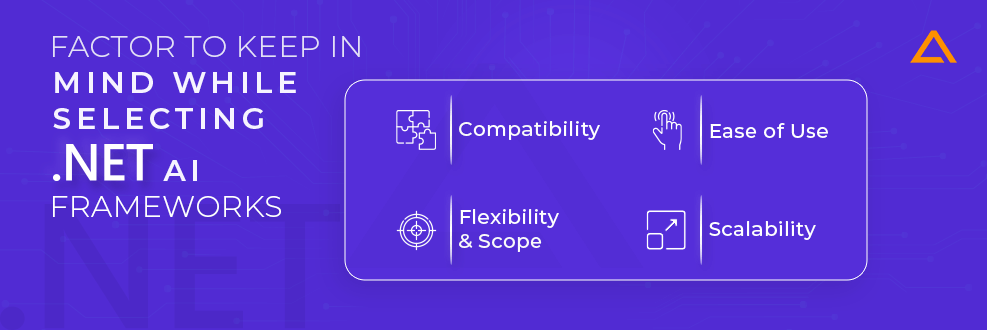
Build and Train the Model
Now, you are ready to start forging your weapon! Train the machine learning model with the chosen library from a list of .NET AI frameworks.
The steps to build and train your .NET AI Model include –
- Data Preprocessing: refers to the process of preprocessing the data for training.
- Feature Engineering: selecting and transforming relevant features for input.
- Model Selection: select the most appropriate machine learning algorithm.
- Training: Use this prepared data to train your model.
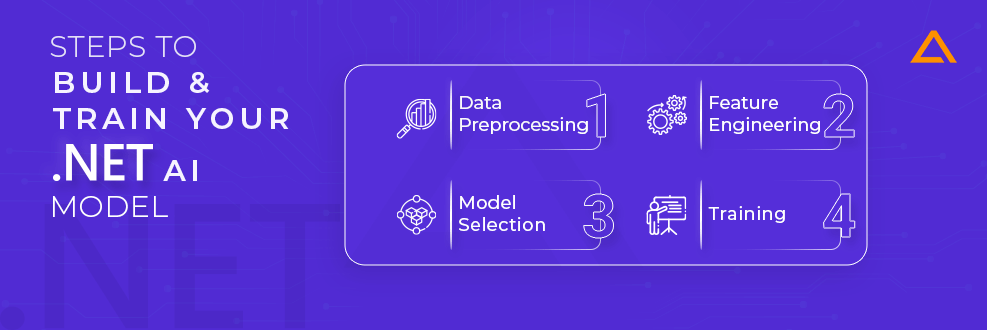
Integrate Machine Learning in .NET App
Once you have trained the model properly, you can integrate it into your .NET application. The implementation and integration would differ as per the selected .NET AI tool.
Monitor, Update, and Train your Model
Learn to continuously monitor the .NET app performance, check for the machine learning implementation’s accuracy, and study how it adapts and responds to user requests.
You can keep a proper eye on the health of your AI-based .NET app by checking factors such as –
- Logging: implement logging mechanisms to capture information about model predictions and any possible issues.
- Monitoring: set up a proper monitoring environment to detect deviations in the model performance.
- Update and Retrain: keep updating the model in set intervals with new data and retrain it to improve accuracy over time.

Why are AI and ML Important for .NET Applications?
Integrating AI and ML in .NET applications has emerged as a transformative force for enterprises wanting to break the barriers of traditional limitations and improve operational efficiency.
Even for applications performing well and smoothly without the interference of AI and ML, integration of such services serves more than improved functionality. It infuses intelligent algorithms that open new possibilities, providing data-driven insights and a competitive edge.
Here are some of the many benefits of adding AI/ML to your .NET app –

Operation Automation
AI/ML brings a monumental shift in improving any organisation’s operational capacity. NET-based applications. When you leverage machine learning algorithms with routine and repetitive tasks, you can automate them with improved efficiency and accuracy. Not only does this free your team from mundane development processes, it also allows the developers to focus on other important aspects of your .NET development process by following the .Net Core Best Practices.
Predictive Analysis
AI/ML can also be used for predictive analysis. This would work well for .NET apps like weather forecasting apps or sports score analysis apps, which are supposed to forecast future trends based on historical outcomes and other important stats. This predictive analysis could be used to understand customer behavior, market behavior, resource requirements, and many other such use cases.
Fraud Detection
Machine Learning in .NET can also be used for fraud detection with the pattern recognition feature of ML libraries. ML models can be trained to detect anomalies and fraudulent activities by analyzing historical data and real-time transactions. This is best suited for e-commerce sites or any software where security is paramount.
Chatbots and Virtual Assistants
You can also integrate AI-driven chatbots and virtual assistants into your .NET applications to enhance user interactions and support. These smart bots can understand customer queries using natural language processing, provide instant responses, and improve based on repetitive user interactions over time. Chatbots can improve customer service and conversions in your .NET application.
Personalization
AI and ML in .NET applications can help personalize experiences for an individual user of your services by learning more about their preferences, browsing habits, or other such algorithms. This can be in the content recommendation on a streaming service app, product suggestions on an e-commerce storefront, or any such use cases. This level of personalized user experience can help improve your customer retention rates significantly.

Seeking brilliance in the AI/ML universe?
Look no further!
Our squad of skilled AI/ML developers @ Aglowid is here to turn your tech dreams into a reality. Let’s add some serious flair to your AI endeavors!
Top .NET Machine Learning Frameworks and Libraries
Now that we have understood how and why to integrate AI and machine learning in .NET, let us look at the leading .NET Machine Learning Frameworks and Libraries you can make use of in 2024 –

1. ML.NET
ML.NET is a Microsoft open-source and cross-platform machine learning framework built for the .NET platform. If you hire .NET developers and train them in ML.NET, they will easily be able to integrate machine learning capabilities in your .NET app without needing any prior machine learning experience.
Key Benefits of ML.NET
- Seamless integration into existing .NET applications
- Machine Learning expertise is not required
- Support for various ML tasks: classification, regression and clustering
- Extensive support for pre-built components for basic machine learning models
- Extended support for other ML libraries like TensorFlow, ONNX, Infer.NET, and more
- Popularly used in big Microsoft projects like Power BI, Outlook, and Bing.
Key Features of ML.NET
- Sentimental Analysis
- Product Recommendation
- Price Prediction
- Object Detection
- Customer Segmentation
- Fraud Detection
- Image Classification
- Sales Spike Detection
- Sales Forecasting
2. TensorFlow.NET
TensorFlow.NET is a .NET standard binding for TensorFlow. It aims to make TensorFlow API completely available in C# for .NET developers to develop, train, and deploy high-level machine learning models in their .NET applications. It also comes with the built-in high-level Keras interface. Since the APIs are kept as similar as possible, .NET developers can almost immediately adapt any TensorFlow code in C# or F# without reinventing the wheel.
Key Benefits of TensorFlow.NET
- Seamless Integration of TensorFlow models with .NET framework
- Provides .NET developers with TensorFlow’s extensive machine-learning models
Key Features of TensorFlow.NET
- Image Classification
- Speech Recognition
- Natural Language Processing
- Facial Recognition
- Object Detection
- Neural Network Development
- Transfer Learning
- Game AI
- Robotics
- Fraud Detection
- Medical Imaging
- Disease Prediction
- Custom Models
3. The Microsoft Cognitive Toolkit (CNTK)
CNTK.NET is a set of .NET bindings that allows .NET developers to leverage the Cognitive Toolkit in the .NET ecosystem. CNTK is an open-source deep-learning framework built by Microsoft. It can be used to train DNN (deep neural networks) and is popularly known in the AI/ML community for its high performance, scalability & support for distributed training.
Key Benefits of CNTK.NET
- Known for high-performance capabilities, making it ideal for training deep neural networks
- Support for training across multiple GPUs, enabling parallel processing
- Flexibility in defining and structuring deep neural network architectures
- Supports various data types like floating numbers and integers
- Cross-platform support, including Windows and Linux
- CNTK integrates seamlessly with Microsoft Azure, enabling scaling machine learning models on the cloud
Key Features of CNTK.NET
- Image and Object Recognition
- NLP
- Speech Recognition
- Time Series Analysis & Forecasting
- Custom Machine Learning Solutions
- Predictive Analysis
- Deep Neural Networks
4. DLib
DLib is a modern C++ Toolkit that contains .NET AI development tools and machine learning algorithms for developing complex software solutions. It can be used for industrial purposes and several other domains, such as robotics, mobile phones, embedded devices, and high-performing computing environments.
Key Benefits of Dlib
- Ideal of image processing, which contributes to the efficient analysis of visual data
- Works well with face detection and recognition
- Comes with many machine-learning algorithms
- Cross Platform compatibility with macOS, Windows, and Linux
Key Features of DLib
- Face Detection
- Image Segmentation
- Hand Gesture Recognition
- Emotion Detection
- Object Recognition and Classification
- Biometric Authentication
- Machine Learning Model Testing
Wrapping up!
This is the ultimate guide to Integrate AI and ML with .NET applications. You already saw the potential ML NET benefits in day-to-day tasks like managing workflows, automating mundane tasks, predictive analysis and forecasting, and creating AI-driven chatbots. The possibilities for AI/ML in .NET applications are endless, and it’s time for you to join the bandwagon! Get your .NET application the much-needed makeover it deserves with a reliable .NET development company.
